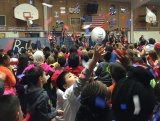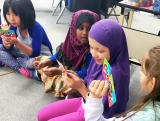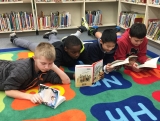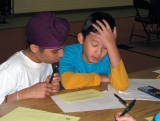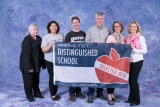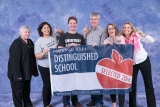-
Category 1
Selected in 2016
-
Grades: k - 6
School Setting: urban
Town Population: 126
Student Enrollment: 683
Student Demographics:
Black/African American: 13%
Teacher/Student Ratio: 1:19
White/Caucasian: 28%
Hispanic: 16%
Hawaiian/Pacific Islander: 2%
Asian: 34%
Native American: 0%
Other: 7%
% Reduced Lunch: 49%
% ELL Learners: 29%
Founded: 1987 -
PRINCIPAL:
Gregory Kroll -
CONTACT:
12711 SE 248th Street
Kent, WA 98030
253-373-7314
gregory.kroll@kent.k12.wa.us
Martin Sortun Elementary
Kent, WA
Every Day is a training day to Be Kind, Be Safe, Be the BEST you can be. We always celebrate what we value.
- Describe specific programs in place to ensure that families are involved in the success of your school and students.
- With a focus on the positive, we reward and celebrate consistent attendance at school. This issue is a part of our school culture and keeping it in the forefront of students’ (and families’) minds has earned our school the highest attendance in our district of 40 schools. For students with attendance issues, parents are invited to conferences where we discuss the impact of absences on their child’s learning. Besides the grade-level family nights mentioned earlier, extracurricular activities also help families stay connected. We have a number of opportunities and performances outside of the school day including choir, band, orchestra, musicals, drama, volleyball, climbing club, track, running club, movie nights, Math Olympiad, robotics, and more. Parent conferences (and the accompanying PTA-run book fair) are well attended as we all work together to help each student and family achieve success.
- Describe the most successful activity your school has initiated to strengthen ties to your community.
- We have found success in strengthening ties to our community by hosting grade-level parent nights. Each teacher team selects a focus or theme and invites families to attend. Daycare and snacks are provided, making the events more viable for families. During these programs, along with providing books to students, we teach parents how to develop comprehension with their children and stress the importance of reading. This is especially important at grades K and 1. Just last week we had a wonderful “Frozen” themed kindergarten night. Using this grade-level format, we are able to differentiate for our parents while reducing overcrowding, given our large population. Administrators assist and participate alongside teachers during family nights, giving parents a chance to interact with them as well.
- Describe your philosophy of school change or improvement.
- At Martin Sortun, change is the constant. We are continuously responsive to changing needs and are committed to providing the latest research-based resources and methods to our students – Whatever It Takes! While we do not avoid change, we try to manage the workload that it inevitably brings by planning for it and providing as much time as we can for the implementation or development of the change. We do not adopt everything. Rather, we analyze the effect size of the initiative and select the change that will provide the greatest potential benefit. In the past year, we have become a 1:1 school with laptops for all students in addition to accelerating our efforts to integrate problem-based learning as a STEM lighthouse school. We recognize both initiatives require a significant amount of development time and several years will be required to realize the potential of each on student learning. Staff support includes planning time, professional development, coaching, resources, and snacks!
- What are your school’s top two goals for the next year?
- First, we will work continually and collaboratively to align and narrow our focus on efficient standards-based instruction. Second, we will continue to improve our instructional program by integrating problem-based STEM instruction into our program.
- What is the single most important factor in the success of your school that others could replicate?
- Perhaps the most important factor is deciding when to color outside the lines. With that in mind we will bend the parameters of this question and list three factors rather than just one. Number one: Let the standards, not the curriculum, drive instruction. Understand not only what the standards require, but how the standards will be measured. Beyond the skills and concepts, teach students to understand how they will be asked to demonstrate their learning. It is not sufficient to only teach students skills and content. We also teach students how to show what they have learned by putting their learning into sentence stems and formatting similar to the state assessments. Two: Build a collaborative, collegial, and positive environment for staff and students where minds (including the administrators’) are continuously open to new and different ideas and approaches. Three: Work hard to find and hire the best staff possible – people who are positive, enthusiastic, creative thinkers.
- Describe the program or initiative that has had the greatest positive effect on student achievement, including closing achievement or opportunity gaps, if applicable.
- Our Response to Intervention (RTI) program has allowed us increased opportunity to differentiate and accelerate our instruction to address the varied needs of our students. Along with our certificated specialists, we use our Title/LAP, English Language Learner, and Special Education funding to hire paraeducators who provide targeted instruction. Employing the data from formative and summative assessments, students receive intentional instructional opportunities in both reading and math. Monitoring student performance on curriculum-based assessments allows us to identify instructional priorities requiring the additional time and attention small group instruction provides. RTI groups include intensive and strategic interventions as well as acceleration opportunities. As students learn, their data is reanalyzed and they are regrouped as needed throughout the year. RTI allows us to provide the best fit for each student.
- Explain how Title I funds are used to support your improvement efforts.
- By far, the largest chunk of our Title 1 funds is used to hire instructional paraeducators who implement our Response to Intervention (RTI) program. These intervention specialists provide focused instruction in a small group setting, offering our students the differentiated instruction they need. Students have varied needs and learn at different rates. Continued regrouping allows our paraeducators to narrow their focus and provide additional practice to those students requiring the most support. Some funding is allocated to professional development. We hire substitute teachers to provide release time for our classroom teachers. Our teacher teams use this time to deconstruct standards, analyze student performance, develop instructional strategies, and/or refine learning resources with job-embedded coaches. The final amount of funding is allotted to family involvement activities where teachers share learning strategies with parents to use at home.
- Identify the critical professional development activities you use to improve teaching and student learning.
- Job-embedded coaching in reading, math and STEM serve to accelerate the adoption and implementation of strategies. Coaches work with staff in many ways – through book studies, late start days, workshop days, email, during before or after school professional development, individual meetings, and on grade-level team release days. Coaches also provide model lessons and co-teach alongside instructional staff to help refine skills and strategies. Staff and coaches routinely meet during weekly Professional Learning Community times to develop a shared understanding of standards-based learning, to streamline practices, and to develop formative assessments. Coaches and specialists also find and/or create resources, posters, notebooks, and templates for staff and students.
- Describe how data is used to improve student achievement and inform decision making.
- Student assessment results drive our decision-making processes. We analyze our student performance to target student growth, determine areas of misconception, monitor programs and instructional interventions, and determine which standards require re-teaching or reinforcement. Curriculum-based formative assessments help us group and regroup our students to differentiate both resources and strategies. Over the past several years, we have increased the use of teacher-developed formative assessments. Our formative assessments align directly with the standards. Collaborative data discussions with teachers and coaches help us develop the scope, sequence, and pacing of our curriculum. Job-embedded coaching provides continuous program refinement, employing new or more efficient strategies to maximize student learning.
- Describe your school culture and explain changes you’ve taken to improve it.
- Successfully Preparing All Students for Their Futures is our district’s mission statement. At Martin Sortun we added the phrase Whatever It Takes. Teachers and students know that every child can succeed. Our students know that whatever you dream, you can achieve. Our job is to continually provide them with the tools and support needed to reach their dreams. They know their school is a safe, nurturing environment where adults have high expectations for them and will help them work toward their goals. When they step onto campus every morning our students feel the sense of community and the culture of life-long learners. Staff take responsibility for all students in our school where norms are reinforced in every room, hall, and playground. Schoolwide assemblies and our morning pledge help us establish and maintain our culture, reinforcing our motto that Every Day is Training Day as well as our core values to Be Kind, Be Safe, Be the BEST you can be. We always celebrate what we value.
Stats
-
Category 1
Selected in 2016
-
Grades: k - 6
School Setting: urban
Town Population: 126
Student Enrollment: 683
Student Demographics:
Black/African American: 13%
Teacher/Student Ratio: 1:19
White/Caucasian: 28%
Hispanic: 16%
Hawaiian/Pacific Islander: 2%
Asian: 34%
Native American: 0%
Other: 7%
% Reduced Lunch: 49%
% ELL Learners: 29%
Founded: 1987 -
PRINCIPAL:
Gregory Kroll -
CONTACT:
12711 SE 248th Street
Kent, WA 98030
253-373-7314
gregory.kroll@kent.k12.wa.us



